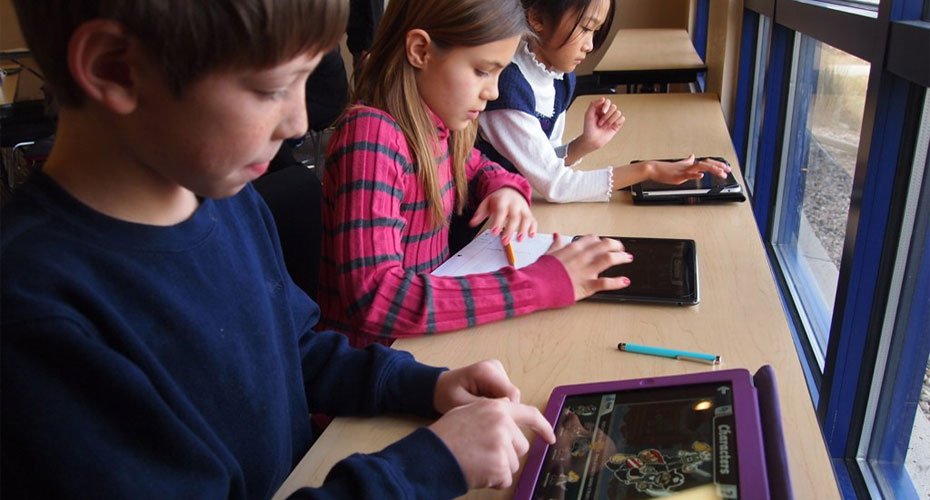Visit 3 Activity 5
Reading for information to make mini mind-maps
Context:
9 :10 – 10:16
Children are sitting in pairs at tables, as before. They have loaded the interactive scene and are engaging with it. The teacher is pinning A4 images of the forest creatures to the working wall behind her desk. The focussed lesson objectives and independent task from the previous lesson are displayed on the Whiteboard. The children are continuing to write diary entries about their experience entering the forest. The children will use to interactive scene to make mini mind maps to describe the creatures they will meet in the forest.
Key activities
- Teacher reviews prior learning – grammar, peer feedback and editing
- Teacher models how to find and read information using the interactive scene to make a mini mind map
- Children read information about the different creatures (from pop-out boxes in the interactive resource)
- Children create mini mind maps about each creature on a printed image of each character
- Teacher models how to justify choosing a character
- Children write justifications using sentence starters (writing frame)
- Children add annotated images to the learning wall
- Children read work aloud for feedback
- Teacher uses working wall to review each character’s attributes
- To justify our choices for choosing one creature to help our character find Jakob and Maria
- To use a variety of nouns and sentences to label a picture of our chosen creature
- Chromebooks (one per child)
- Interactive scene: The Bewitched Forest – Inspire Literacy
- Direct teaching
- Shared reading and meaning making
- Peer feedback
- Teacher explaining activity and demonstrating use of interactive scene pop-out boxes
- Teacher modelling mini mind mapping
- Use of learning wall to present annotated images of characters from the interactive scene’s pop out boxes
- Editing
- Mind mapping
- Comprehension – inference and deduction/ answering posed questions
- Understanding character presentation
- Evaluation and decision making
- Perspective-taking (empathy)/ standing in someone else’s shoes
- Discussion
- Justification and reasoning
- Knowledge of how to construct expanded noun phrases
- Knowledge of function of adjectives to describe nouns
- Practicing how to build a character for inclusion in narrative
- Navigation around interactive scene
- Selecting key information
- Do children enjoy interrogating the interactive scene to find information about story creatures (reading for information)
- Do children engage with the interactive scene to make meaning (reading for meaning) relevant to the task?
- Are children engaged in writing justifications based on their research in the interactive scene?

Lesson Commentary
Introduction
The teacher reminds children of the previous lesson’s objective (WALT): to use knowledge of expanded noun phrases to describe ‘The Bewitched Forest’ effectively. Using the IWB, she displays a colour coded text to illustrate expanded noun phrases in yellow, and asks children to share examples of effective descriptions (from yesterday).
- Children are easily working across multiple digital and non-digital resources. Desks are very busy
- Use of digital resources is interspersed with traditional pedagogies, e.g. chalk and talk style instruction about grammar/ review of learning
- Teacher has to model new elements. She does not rely on children’s intuition with digital resources
- Chromebook lids are closed to support refocus of children’s attention to teacher modelling
- Children struggle with shift from independent work with digital resource to focusing on teacher; teacher has to labour hard
- High levels of excitement (chatter/ noise/ movement) calm as children focus on their activity, but there is still collaborative chatter, supporting the learning
- Children’s focus shifts easily from Chromebook, to partner, to non digital resources, to partner’s Chromebook; however, their learning appears anchored by the Chromebook
- Children’s literacy is truly multimodal, they are listening, watching, reading (decoding), talking, and transcribing – all as part of the writing process (making mind-map); however the transcription is monomodal – pen onto paper
- The children are occupying a range of positions as they build to being the storyteller; they are a participant in the world; they are a critic of the characters in the world; they are a narrator – telling others about their time in the world
- The children own the writing process. They are in a state of ‘flow’
- Children struggle to refocus on teacher, when she introduces new activity. Children cannot repeat back instructions. She has to be very firm and restate expectations for attention
- Children have to adjust in their role as learners from working with digital resources, back to more traditional pedagogies. This role change can be challenging
- Children are overwhelmed by the task of writing a justification – possibly due to genre switch. Time and modelling needed to support learning as genre is changed (mind-map to justification)
- Digital resources and formal writing resources approaches can be blended within one activity
- Teachers need to model use of digital resources, in the same way that they might model formal approaches to writing
- To refocus children’s attention, digital resources may need to be closed
- Time and effort need to be planned into lessons to support the shift from one way of working to another, when working with digital resources
- It is hard for children to shift their role as learners, from working in one mode (in a digital world), to working in a more formal way
- Meaning making can be supported by multimodal texts with sound, graphics, movement. animation, etc. which can support composition in paper-based formats
